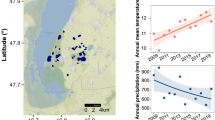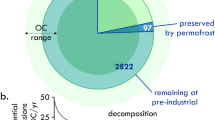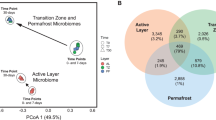Abstract
In the transition zone of the shifting permafrost border, thaw ponds emerge as hotspots of microbial activity, processing the ancient carbon freed from the permafrost. We analyzed the microbial succession across a gradient of recently emerged to older ponds using three molecular markers: one universal, one bacterial and one fungal. Age was a major modulator of the microbial community of the thaw ponds. Surprisingly, typical freshwater taxa comprised only a small fraction of the community. Instead, thaw ponds of all age classes were dominated by enigmatic bacterial and fungal phyla. Our results on permafrost thaw ponds lead to a revised perception of the thaw pond ecosystem and their microbes, with potential implications for carbon and nutrient cycling in this increasingly important class of freshwaters.
Similar content being viewed by others
Log in or create a free account to read this content
Gain free access to this article, as well as selected content from this journal and more on nature.com
or
References
Abnizova A, Siemens J, Langer M, Boike J . (2012). Small ponds with major impact: the relevance of ponds and lakes in permafrost landscapes to carbon dioxide emissions. Global Biogeochem Cy 26: GB2041.
Brown CT, Hug LA, Thomas BC, Sharon I, Castelle CJ, Singh A et al. (2015). Unusual biology across a group comprising more than 15% of domain Bacteria. Nature 523: 208–211.
Comte J, Monier A, Crevecoeur S, Lovejoy C, Vincent WF . (2016). Microbial biogeography of permafrost thaw ponds across the changing northern landscape. Ecography 39: 609–618.
Crevecoeur S, Vincent WF, Comte J, Lovejoy C . (2015). Bacterial community structure across environmental gradients in permafrost thaw ponds: methanotroph-rich ecosystems. Front Microbiol 6: 192.
Harms H, Schlosser D, Wick LY . (2011). Untapped potential: exploiting fungi in bioremediation of hazardous chemicals. Nat Rev Microbiol 9: 177–192.
Logue JB, Stedmon CA, Kellerman AM, Nielsen NJ, Andersson AF, Laudon H et al. (2016). Experimental insights into the importance of aquatic bacterial community composition to the degradation of dissolved organic matter. ISME J 10: 533–545.
Monchy S, Sanciu G, Jobard M, Rasconi S, Gerphagnon M, Chabé M et al. (2011). Exploring and quantifying fungal diversity in freshwater lake ecosystems using rDNA cloning/sequencing and SSU tag pyrosequencing. Environ Microbiol 13: 1433–1453.
Negandhi K, Laurion I, Whiticar MJ, Galand PE, Xu X, Lovejoy C . (2013). Small thaw ponds: an unaccounted source of methane in the Canadian High Arctic. PLoS ONE 8: e78204.
Nilsson RH, Wurzbacher C, Bahram M, Coimbra VRM, Larsson E, Tedersoo L et al. (2016). Top 50 most wanted fungi. MycoKeys 12: 29–40.
Peura S, Eiler A, Bertilsson S, Nykänen H, Tiirola M, Jones RI . (2012). Distinct and diverse anaerobic bacterial communities in boreal lakes dominated by candidate division OD1. ISME J 6: 1640–1652.
Probst AJ, Castelle CJ, Singh A, Brown CT, Anantharaman K, Sharon I et al. (2016). Genomic resolution of a cold subsurface aquifer community provides metabolic insights for novel microbes adapted to high CO2 concentrations. Environ Microbiol 19: 459–474.
Przytulska A, Comte J, Crevecoeur S, Lovejoy C, Laurion I, Vincent WF . (2016). Phototrophic pigment diversity and picophytoplankton in permafrost thaw lakes. Biogeosciences 13: 13–26.
Roiha T, Laurion I, Rautio M . (2015). Carbon dynamics in highly net heterotrophic subarctic thaw ponds. Biogeosciences 12: 7223–7237.
Rossi PG, Laurion I, Lovejoy C . (2013). Distribution and identity of Bacteria in subarctic permafrost thaw ponds. Aquat Microb Ecol 69: 231–245.
Tranvik LJ, Downing JA, Cotner JB, Loiselle SA, Striegl RG, Ballatore TJ et al. (2009). Lakes and reservoirs as regulators of carbon cycling and climate. Limnol Oceanogr 54: 2298–2314.
Vonk JE, Sanchez-Garcia L, van Dongen BE, Alling V, Kosmach D, Charkin A et al. (2012). Activation of old carbon by erosion of coastal and subsea permafrost in arctic Siberia. Nature 489: 137–140.
Wrighton KC, Thomas BC, Sharon I, Miller CS, Castelle CJ, VerBerkmoes NC et al. (2012). Fermentation, hydrogen, and sulfur metabolism in multiple uncultivated bacterial phyla. Science 28: 1661–1665.
Acknowledgements
We thank the CEN Whapmagoostui-Kuujjuarapik Station and Claude Tremblay for the use of laboratory space and transportation to the SAS2 site. Karólína Einarsdottir, Maxime Wauthy, David-Alexandre Gauthier, Felix Faucher, and Julien Lebrun are acknowledged for their help with the sampling, Caroline Ponsonby for the map of the sampling site, Pilar Lopez-Hernandez for her help with the molecular laboratory work, Alexander Eiler for processing the bacterial amplicon data, and Jerome Comte for comments on an early draft of the manuscript. The funding was provided by the Academy of Finland (grant 265902 to SP), the International Network for Terrestrial Research and Monitoring in the Arctic (INTERACT; grant to SP), and the Marie Skłodowska-Curie actions (grant CRYPTRANS to CW). Financial support was further provided by the Natural Sciences and Engineering Research Council of Canada (NSERC) and the Canada Research Chair program.
Author information
Authors and Affiliations
Corresponding author
Ethics declarations
Competing interests
The authors declare no conflict of interest.
Additional information
Supplementary Information accompanies this paper on The ISME Journal website
Rights and permissions
About this article
Cite this article
Wurzbacher, C., Nilsson, R., Rautio, M. et al. Poorly known microbial taxa dominate the microbiome of permafrost thaw ponds. ISME J 11, 1938–1941 (2017). https://doi.org/10.1038/ismej.2017.54
Received:
Revised:
Accepted:
Published:
Issue date:
DOI: https://doi.org/10.1038/ismej.2017.54
This article is cited by
-
Exploring prokaryotic diversity in permafrost-affected soils of Ladakh’s Changthang region and its geochemical drivers
Scientific Reports (2025)
-
Metaproteogenomics resolution of a high-CO2 aquifer community reveals a complex cellular adaptation of groundwater Gracilibacteria to a host-dependent lifestyle
Microbiome (2024)
-
The economical lifestyle of CPR bacteria in groundwater allows little preference for environmental drivers
Environmental Microbiome (2021)
-
Community composition of aquatic fungi across the thawing Arctic
Scientific Data (2021)
-
Emergent biogeochemical risks from Arctic permafrost degradation
Nature Climate Change (2021)



